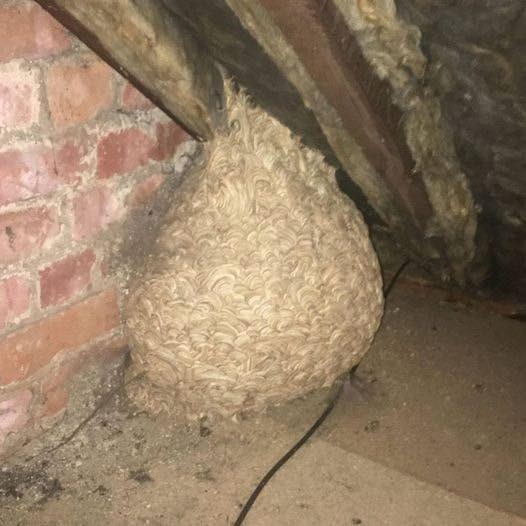ADVERTISEMENT
But it wasn’t until he poked at it a little more that he realized what was really inside. As the nest’s outer layer started to peel away, the man’s jaw dropped. The nest wasn’t made by hornets or bees at all—it was a mass of old, carefully organized wasp larvae. These larvae were seemingly encased in something that looked like discarded fabric, but when he inspected the center, he could see small threads and fibers that had once been part of some larger, intricate system.
Upon further inspection, he realized the “nest” wasn’t even a wasp nest at all—it was actually something entirely different, and the man turned pale when he realized the truth: the nest was actually a cluster of discarded materials—likely a forgotten project—tangled with old insulation and fabric. Inside, the man found remnants of a long-dead rodent, likely a mouse or squirrel, that had found its way into the attic years ago.
### The Horrifying Truth: It Wasn’t a Hornet’s Nest, But an Animal’s Nest
As he pieced everything together, the man realized he had been staring at the remnants of a rodent’s nesting attempt. The “nest” was actually a combination of fabric and debris that had been used by the animal for warmth and shelter. The resemblance to a hornet’s nest had been purely coincidental. The small holes were likely gnaw marks or places where the creature had burrowed through the material to find its way to safety. Over time, the animal had died, leaving behind a decaying nest in the attic.
For anyone who has ever lived in an old house, the idea of a rodent making a home in the attic is not far-fetched. Rats, mice, and squirrels often seek out quiet, dark places like attics to nest, where they can stay hidden away from predators and human activity. What the man had found in his attic was the remnants of a natural process that had gone unnoticed for years. It wasn’t a hornet’s nest at all, but the carefully crafted home of a rodent that had long since perished.
The truth was unnerving, but it was also a reminder that attics are often used by more than just humans to find shelter. It was also a call to action for him to be more vigilant about the condition of his attic and to make sure it was properly cleaned and sealed off to prevent any more unwelcome visitors from making it their home.
### How to Handle Unexpected Attic Discoveries
Now that the mystery of the attic nest had been solved, the man needed to take steps to deal with the aftermath. His next course of action involved addressing the fact that the attic could have been the site of a rodent infestation. Whether it was a family of rats, mice, or squirrels, it was important to clear the area and make sure there were no remaining creatures or hazards.
#### 1. **Remove the Nests and Debris**
The first step was to clear the remnants of the nest and any other debris in the attic. If you find an old nest, it’s crucial to remove all materials, including any fabric, insulation, or leftover items that might have been used to create the nest. Use gloves and a face mask to avoid direct contact with anything potentially harmful.
#### 2. **Inspect for Signs of Rodent Activity**
Once the nest was cleared, the man conducted a thorough inspection of the attic. He looked for any signs of further rodent activity, such as droppings, gnaw marks, or entry points. Rodents are known to chew on wires, insulation, and wood, so any evidence of gnawing or chewing should be taken seriously. If you spot any damage, it’s time to take further action.
3. **Seal Entry Points**
To prevent future infestations, the man carefully sealed off any holes, cracks, or gaps that could have allowed the rodents to enter the attic. This might involve using steel wool, caulk, or weather stripping to block off the entry points.
For Complete Cooking STEPS Please Head On Over To Next Page Or Open button (>) and don’t forget to SHARE with your Facebook friends
